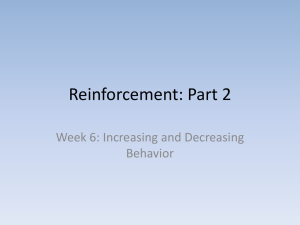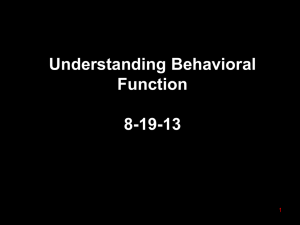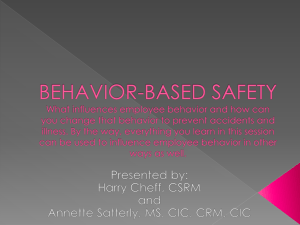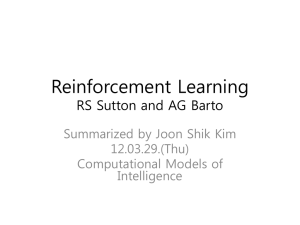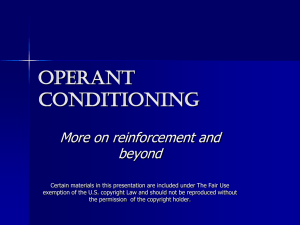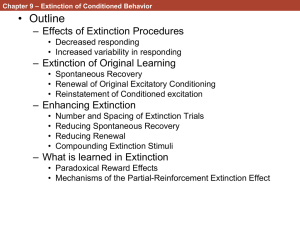lecture 6 - Nic Hooper, PhD
advertisement
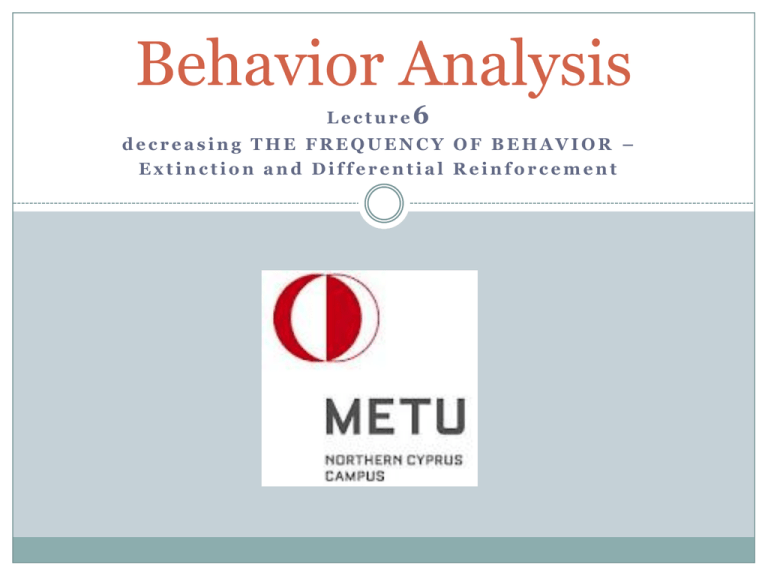
Behavior Analysis Lecture6 decreasing THE FREQUENCY OF BEHAVIOR – Extinction and Differential Reinforcement Review Most behavior problems fall into one of two categories Behavior that doesn’t occur enough Behavior that occurs too much So far we have addressed how to increase the frequency of behavior Reinforcement Prompting, Fading, Shaping and Chaining are procedures used with reinforcement to increase behavior rate Now we will learn how to decrease the frequency of behavior In other words, in certain behavior problems the target behavior occurs too much, we need to learn how to reduce the amount of times the target behavior occurs Review Can we think of any examples? Parents often complain that their kids Talk on the phone too much Eat too much Go out too much Complain too much Cost too much Teachers may complain that their students Walk around the room too much Fight too much Cry too much Call out answers too much With these problems the task is not to strengthen behavior, but to weaken it! Today's lesson Today we discuss two procedures used for reducing the frequency of behavior Extinction Differential reinforcement Extinction Operant behavior is maintained by its consequences. Therefore, preventing the consequences that maintain a behavior should weaken it. In other words, problematic behavior is likely to pay off because the consequences following the behavior are reinforcing Therefore if we stop the reinforcing consequences then we would expect the behavior to occur less often This is extinction Extinction: withholding the reinforcers that maintain a target behavior Extinction Behaviorists often talk about a behavior as having been‘extinguished’ When they say this they mean that the frequency of the behavior has been reduced by the extinction procedure Note: extinction does not mean that the behavior no longer occurs or is ‘extinct The effect of extinction is to reduce the frequency of the target behavior Example Nellie taps her fingers during work 5 or 6 times day. One day a co worker asks Nellie if she is ok. This leads to a conversation about Nellie’s feelings that Nellie finds reinforcing. The finger tapping therefore increase to around 30-40 times per day. Then the co-worker moves to a different job. The reinforcer is no longer available. So the finger tapping reduces to pre intervention rates: 5 or 6 times per day Lets look at some case studies: Bill, the crier When young children cry after falling over, crying is to be expected. However sometimes young children cry for no reason, which may annoy others and interfere with their own healthy development. Bill was one such child Bill, the crier Bill was a normal healthy boy He had above average intelligence and good social skills However Bill cried more than any other child in school, around 5 to 10 times per morning Near enough anything was enough to make Bill cry, and when he cried, the whole school knew about it Bill would only stop crying after the teacher comforted him for several minutes Teachers began to wonder if Bill cried because of the attention he received when he cried Hart et al (1964) Betty Hart agreed that attention might be the reinforcer and decided to see if extinction might help To begin with, teachers measured each time Bill cried with a pocket counter The target behavior was defined as crying that last for 5 seconds and could be heard from 50 foot away At the end of each day someone recorded the total number of crying episodes on a cumulative graph The teachers did this for 10 days to get a baseline, there was no effort to modify Bills behavior Hart et al (1964) After 10 days, treatment consisted of putting crying on extinction This meant that when Bill cried teachers were to look his way to make sure that Bill was not hurt, after which they were to pay no attention to him Each time Bill had an unpleasant experience and did not cry, then the teacher was to give Bill praise and attention The results indicated that the frequency of crying fell dramatically, so that after 5 days of extinction Bill was crying only two times per day In order to make sure that it was the intervention that powered the change, the researchers employed an ABAB design. The results held up. Lets draw the graph! Extinction Extinction is basically a very simple procedure: prevent the target behavior from occurring by withholding consequences and it declines But, as with reinforcement, it can be difficult to successfully apply In fact it can be pretty easy to make a mess of things There are some rules for extinction that will help you Define the target behavior Identify the reinforcers that maintain the target behavior Withhold all reinforcement of the target behavior Monitor the results Define the target behavior Defining the target behavior is just as important when it comes to decreasing the rate of behavior as it is when attempting to increase the rate of behavior You must always have a very clear and operational idea of what the target behavior is Identify the reinforcers that maintain the target behavior If operant behavior occurs on a regular basis, you can safely assume that it is being reinforced. To put the behavior on extinction, you have to identify the reinforcer, so that you know what to withhold. However this is easier said than done For example, it is unlikely that a child will say ‘I cry because in the past crying has produced adult attention’. Therefore in order to find the reinforcer you have to work it out by observing the behavior and its consequences for a time A number of consequences may follow a behavior, it is very important to pinpoint the consequence that is functioning as a reinforcer Withhold all reinforcement of the target behavior Extinction involves the target behavior not being reinforced However doing so can sometimes be difficult For example, it is difficult to withhold attention if Bill has fallen over and hurt himself Withhold all reinforcement of the target behavior A more serious example occurs when reinforcement becomes too difficult to control. For example, imagine that every time Jonny shouts out in class, his fellow students laugh. Laughing is the reinforcer here. To put this into extinction you would have to stop the kids laughing at Jonny’s remarks every time he shouts out. This would be very difficult. Notice the words ‘every time’ there. Extinction only works if the reinforcer is with held every time the behavior occurs. Because occasional reinforcement can maintain behavior at very high rates and can even make the behavior more difficult to eliminate Withhold all reinforcement of the target behavior This phenomenon is called Partial reinforcement effect: increased resistance to extinction following intermittent reinforcement. This means that it is not a good idea to start extinction unless you can be sure that you can withhold all reinforcement of the target behavior A good example of PRE is gambling behavior Monitor the results The only way to make sure that extinction is working is to monitor the results. For example if you have gone with the wrong consequence that doesn‘t actually function as a reinforcer then the only way to know is to monitor the results Problems with extinction – uncontrolled reinforcement The problem, as previously mentioned, is that the target behavior may produce reinforcement from a number of sources. And those sources may be difficult to control Another problem occurs when the activity is reinforcing in itself. This makes extinction impossible. For example, how do you extinguish a behavior when you can’t reduce the level of reinforcement? Problems with extinction –slowness Sometimes extinction can be very slow This is a problem because the longer it take for a behavior to extinguish, the more likely people will give up. Also, imagine that the target behavior is severe, like head banging. By the time the extinction procedure has worked the kid could be blind! It is therefore hard to justify using extinction when the behavior is harmful Another example is destruction of property – it is hard to use extinction when things are being destroyed! Problems with extinction – side effects Extinction can produce some dramatic side effects that can be problematic The long term effect of extinction is a steady and pronounced reduction in the frequency of a target behavior But the immediate effect of putting a behavior on extinction is a sudden increase the target behavior For example, Bill might start crying a huge amount of times before the reductions in target behavior began This is called an extinction burst Extinction burst: a sharp increase in the frequency of the behavior on extinction Problems with extinction – side effects Extinction bursts can be a problem because you might easily conclude that the extinction procedure wasn’t working, and give up. It is therefore important to understand, and to inform every party that the behavior may get worse before it gets better Otherwise people are likely to go back to reinforcing the behavior, which may make the behavior occur at a higher rate Problems with extinction – side effects There are two further side effects of extinction: Resurgence Spontaneous recovery Resurgence occurs when behavior that used to produce reinforcement in the past reappears Resurgence: the reappearance, during extinction, of previously effective behavior. Problems with extinction – side effects Imagine little harry learns at home that throwing things across the room gets him what he wants. Then he learns in school that there are more socially acceptable ways to get things i.e. be polite. Harry grows up and gets married, but his wife annoys him but leaving shoes around the place. Harry politely asks her to stop, but one day she forgets (being polite is put into extinction). The next time his wife leaves shoes around the place Harry yells and throw things across the room. Here a behavior which used to produce reinforcement has reappeared Problems with extinction – side effects Resurgence can be compared to Freud’s idea of regression. Freud suggested that immature behavior may reappear later in life. From a behaviorist perspective, any behavior that once produced reinforcement may reappear if another way of obtaining reinforcement is put on extinction Behaviorists therefore have to be very careful not to reinforce unacceptable behavior that has resurged, or it will strengthen Problems with extinction – side effects Sometimes after the successful completion of an extinction procedure, the behavior suddenly reappears without warning, this is called spontaneous recovery Spontaneous recovery: the reappearance of the target behavior following its extinction Spontaneous recovery is not a problem, as long as the behavior is not reinforced when it reappears. Problems with extinction – side effects The difference between resurgence and spontaneous recovery is that in spontaneous recovery the behavior that reappears is the behavior on extinction Whereas with resurgence the behavior that reappears is some other behavior that has produced reinforcement in the past As you can see there are problems with extinction. However these problems can often be overcome is they are used with other procedures. One of these is called differential reinforcement. Differential Reinforcement Differential Reinforcement is an umbrella term for several procedures in which the rate of target behavior is changed by the combined used of extinction and reinforcement Differential Reinforcement: any procedure that combines reinforcement and extinction to change the frequency of a target behavior. Note: you can use DR to increase of decrease the target behavior, today we concentrate on the latter Kinds of Differential Reinforcement Although it may be difficult to understand how reinforcement could reduce the frequency of a behavior, some examples of the kinds of DR will help clarify the situation Lets start simple, we are dealing with problems where the behavior occurs too often. If we want the behavior to occur less often, then it can be a good idea to provide reinforcement for the behavior when it occurs less often. This is called differential reinforcement of low rate (DRL) DRL DRL: the procedure of reinforcing the target behavior when it occurs at a low rate. ‘But how can we reinforce behavior without making it occur less often?’ It sounds crazy but the key difference is that were not just reinforcing the behavior, were reinforcing the behavior only when it occurs at a low rate. Lets think of an example DRL Imagine we have a child (Mike) who eats too fast We want him to eat more slowly This could mean that he currently puts food in his mouth ten times a minute Using DRL we would choose a lower number, say 4 lots of food per minute, and reinforce that behavior. Therefore we are reinforcing the act of eating slowly Differential Reinforcement of Alternate Behavior (DRA) The idea behind DRA is to put the target behavior on extinction, whilst reinforcing some other behavior. DRA: the procedure of reinforcing an alternate behavior instead of the target behavior In DRA reinforcers that were available for the target behavior become contingent of some more acceptable alternate behavior. For example, whereas attention used to be given to a child for screaming, now attention is not given for screaming, but is given for playing quietly with toys Differential Reinforcement of Incompatible behavior (DRI) Imagine I asked you to sit down and walk across the room at the same time? Impossible right? Well that forms the basis for DRI One way to reduce the frequency of an unwanted behavior is to reinforce other behavior that is incompatible with that behavior DRI: the procedure of reinforcing a behavior that is incompatible with the target behavior Differential Reinforcement of Incompatible behavior (DRI) For example, the chief reason why kids get out of their seat in school is the attention that they get from the teacher Some teachers can reduce the frequency of such behavior by ignoring it: putting it on extinction However this may take some time, especially if the students have received attention for wandering for some time. DRI speeds up this process and avoids the negative side effects of extinction This is because DRI creates a situation where the child can still get reinforcement, but they are getting it for a behavior that is incompatible with the target behavior. Now students get attention for being in their seats DRI and DRA are very similar. The difference being that in DRA the ‘other’ behavior being reinforced is not necessarily incompatible with the target behavior Rules for using differential reinforcement Define the target behavior Put the undesirable target behavior on extinction Reinforce the desirable target behavior Monitor the results Define the target behavior With DR, there are generally two target behaviors. You're trying to reduce the frequency of one behavior and increase the frequency of another. In some cases the target behaviors are different rates of the same activity e.g. eating fast versus eating slow Put the undesirable target behavior on extinction Here you need to identify the reinforcers that are maintaining the problematic behavior. When you have done this you must prevent those reinforcers from following the unwanted behavior Reinforce the desirable target behavior While you have the undesirable behavior on extinction, you reinforce the desirable behavior So you put the behavior you want to weaken on extinction, and you reinforce the behavior you want to strengthen Monitor the results You need to make sure that your intervention is producing the desired results. For example your reinforcer may be wrong, or bootleg reinforcement may be causing problems. You will only know these things if you measure what's happening. Flash card Extinction withholding the reinforcers that maintain a target behavior Partial reinforcement effect increased resistance to extinction following intermittent reinforcement Extinction burst a sharp increase in the frequency of the behavior on extinction Resurgence reappearance during extinction of previously effective behavior Spontaneous recovery reappearance of target behavior following its extinction Flash card Differential Reinforcement procedure that combines extinction and reinforcement to change the frequency of a target behavior DRL procedure of reinforcing the target behavior only when it occurs at a low rate DRA procedure of reinforcing an alternative behavior instead of the target behavior DRI procedure of reinforcing a behavior that is incompatible with the target behavior Flash card DRL stands for: Differential reinforcement of low rates DRA stands for: Differential reinforcement of alternative behavior DRI stands for: Differential reinforcement of incompatible behavior

